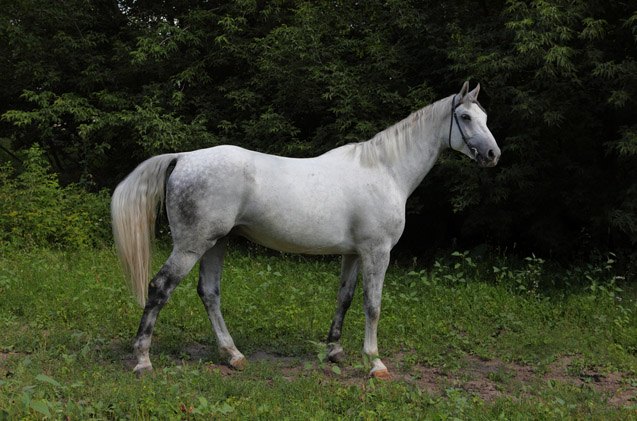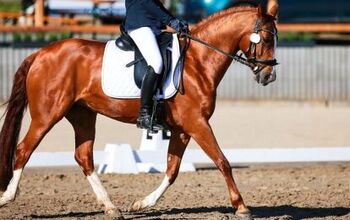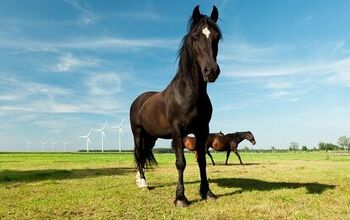Holsteiner Horse


About Holsteiner Horse
The Holsteiner Horse is a breed that has been around for more than 700 years. It originated in Schleswig-Holstein, a region in northern Germany, when a monastery at Uetersen started breeding horses to create a breed that could be used for both work and riding.
Following the Reformation, the government of Germany and private breeders took charge of maintaining the Holsteiner Horse breed, and the breed was changed over time in order to meet various new needs. The horses were used in war, in shows, and as carriage horses, as a few examples. And during the 19th century, Cleveland Bays and Yorkshire Coach horses were also added to the breeding program in order to create an even more animated yet elegant carriage horse.
The Holsteiner is popular in international competitions.
As time went on, the Holsteiner breed was changed again and again in order to keep the horse in demand. For example, following World War II, the demand for a multi-purpose and athletic sport horse was high, so Selle Francais, Anglo-Arab, and Thoroughbred blood was added to the line as well. All of these changes led to this horse becoming strong, versatile, and popular, even in Olympic equestrian sports.
In 1978, the American Holsteiner Horse Association was created. It, along with the Holsteiner Verband of Germany, oversees every aspect of the breeding, registration, and grading of these horses.
Today, the Holsteiner studbook is one of the smallest in Europe, but the breed is still popular in international competitions. And these horses are one of the best sport horses on the planet, so you will find them competing in dressage, jumping, and more.
Holsteiner Horses are known for being easygoing animals, and they are typically quiet. Despite sometimes being a bit lazy, these horses want to perform at their best. They have a generally good temperament, a willingness to work, and great rideability. Plus, these horses are known for their loving personality, as well as their intelligence. Many people who care for these animals find that they become your friend and a wonderful companion in no time.
Keep in mind that every horse is an individual, so one Holsteiner might be lazier or more sensitive than another. If you do not have a lot of experience with horses, you may encounter a cooperative and steady Holsteiner that will be a good horse to start with. And if you are a professional rider, there are also Holsteiners that will be bold and ready for adventurous riding. Generally, though, the majority of Holsteiners are considered confident, reliable, strong-nerved, and well-balanced animals.
The Holsteiner Horse has been around for more than 700 years.
A Holsteiner Horse could be described as large and muscular, yet elegant. They feature a flexible and short topline, along with an arching neck that appears rather graceful. The joints are well angled and strong, and the hind legs step deep underneath the horse’s body.
There are actually two types within the Holstein Horse breed. These include the classic type, which is larger and heavier boned, and the modern type, which is more refined and lighter. Both of these showcase suspension within movements, along with elasticity and balance.
A Holsteiner Horse could be described as large and muscular, yet elegant.
The Holsteiner Horse is one that could showcase all of the solid colors, as they are all acceptable according to breeding standards. However, the various bay shades, along with chestnut, are considered the most commonly seen coat colors for these horses.
Traditionally, the Holsteiner Horse had minimal markings and featured dark colors. Therefore, there is a preference for horses that are brown, dark bay, or black. However, lighter colors, such as gray and chestnut, are permitted in this breed as well. The horses that are excluded from the Holsteiner registry are those that feature any traits that are associated with leopard spotting, as well as those hoses that have large white spots associated with pinto patterning. Also, buckskin and palomino aren’t acceptable colors for this breed either.
Like other equine breeds, the Holsteiner will benefit from a regular grooming routine, and every session is a wonderful opportunity to bond with your horse. A basic grooming kit will be sufficient, and you could also use a gentle equine shampoo whenever necessary to bathe your Holsteiner. Use this time with your horse to look for any signs of infection or injury as well.
Starting with a curry comb, you could use circular motions to loosen any debris and dirt that has collected throughout your horse’s coat. Follow that with a dandy brush, using flicking motions to brush in a manner that will get more dirt off of the coat. Then, you could use a body brush to smooth the hair down and remove any remaining traces of dirt. This brush will also help give the coat a clean and shiny look. When you are done with the body, you can use a mane and tail brush or comb to detangle and clean the mane and the tail. And after you brush your horse’s coat, you can then use a hoof pick to clean debris out of the hooves.
Photo credit: purplequeue/Shutterstock; horsemen/Shutterstock

Lisa Selvaggio is a freelance writer and editor, and our resident cats-pert, with certifications in pet nutrition and pet first aid. She enjoys producing content that helps people understand animals better so they can give their pets a safe and happy home.
More by Lisa Selvaggio

























